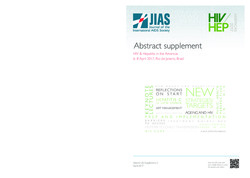Please use this identifier to cite or link to this item:
http://cris.unibe.edu.do/handle/123456789/68| Title: | Implementation model for HIV retention in care in key populations in the Dominican Republic [abstract] | Autores: | Paulino-Ramírez, Robert Brito, C. Rodríguez Lauzurique, Rosa M. Clase, J. Muñoz, M. Valerio, K. Thompson‐Gari, Lorenzo Cabrera‐Bou, Víctor Enríquez, Eva Beatriz Valentín, Lorena Aimar Pérez‐Álvarez, Osvaldo Jiménez, Anyelina Cordero, Cristie Vélez-Vásquez, Gabriel |
Researchers (UNIBE): | Paulino-Ramírez, Robert Thompson‐Gari, Lorenzo Cabrera‐Bou, Víctor Enríquez, Eva Beatriz Valentín, Lorena Aimar Pérez‐Álvarez, Osvaldo Jiménez, Anyelina Cordero, Cristie Vélez-Vásquez, Gabriel |
Affiliations: | Instituto de Medicina Tropical y Salud Global (IMTSAG) Decanato de Investigación e Innovación (DII) Decanato de Investigación e Innovación (DII) Decanato de Investigación e Innovación (DII) Decanato de Investigación e Innovación (DII) Decanato de Investigación e Innovación (DII) Decanato de Investigación e Innovación (DII) Decanato de Investigación e Innovación (DII) Decanato de Investigación e Innovación (DII) |
Research area: | Ciencias de la Salud | Issue Date: | 2017 | Publisher: | John Wiley & Sons Inc. | Source: | Journal of the International AIDS Society, Vol. 20, Suppl. 2 (P037) | Journal: | Journal of International AIDS Society | Volume: | 20 (Suppl. 2) | Issue: | P037 | Conference: | HIV & Hepatitis in the Americas, 6–8 April 2017, Rio de Janeiro, Brazil | Abstract: | Introduction: HIV epidemic in the Dominican Republic (DR) is concentrated amongst key populations (KP), including MSM, transgender and migrants. Despite progress in development of HIV prevention interventions, still we register newly infections amongst these populations. There is a growing interest to evaluate the cascade of care per each KP, separately from general population (GP) and to monitor effectiveness of each intervention that might modify the continuum in care [1,2]. The aim of this study was to evaluate a model of retention focused in key populations in the DR. Methods: We selected three outpatients HIV clinics in the country with more than 5000 patients to evaluate three interventions: early testing, opportune ART medication and viral suppression. We initiate KP despite CD4 count or viral load after psychological assessment, and developed a case navigator model for retention in care[3]. The model of retention included: case tracking and linkage to services, community‐focused services and opportune provision of services on site (HIV/STIs screening, chemistry and screening for HPV infections). We collected data of testing, ART treatment and viral suppression. Results: HIV testing coverage was similar between GP and KP, but the number of positive results was greater in MSM, trans, TRSX and migrant populations (Figure 1). Linkage to care was achieved in 100% of positive cases. At the moment of evaluation 1766 patients were retained in care, and a total of 691 new patients were started in ART. Viral suppression was achieved in 80.2% of the patients (Figure 2). Conclusions: Implementation of community focused interventions for KP will increased the number of positive unknown results amongst most‐at‐risk populations by 18% (normal average in concentrated populations 2–5%), and an increased number of early provision of ART, and a sustained viral suppression will substantially reduce HIV transmission. |
URI: | https://cris.unibe.edu.do/handle/123456789/68 | DOI: | 10.7448/IAS.20.3.21954 |
| Appears in Collections: | Publicaciones del IMTSAG-UNIBE Publicaciones indexadas en Scopus / Web of Science |
Files in This Item:
| File | Description | Size | Format | |
|---|---|---|---|---|
| Abstract supplement HIV & Hepatitis in the Americas 6–8 April 2017.pdf | Full text [open access] full issue | 4.02 MB | Adobe PDF |  View/Open |
This item is licensed under a Creative Commons License

